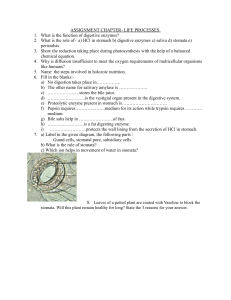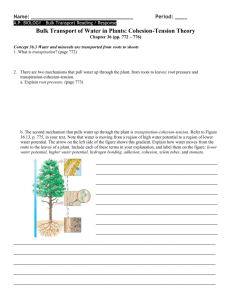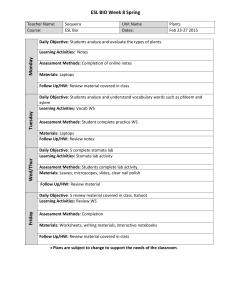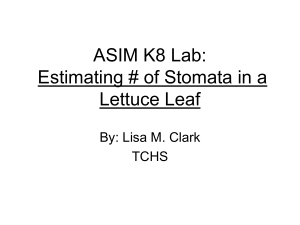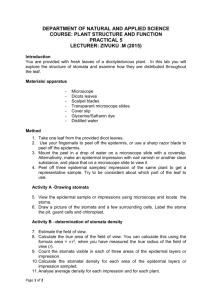Yakima WATERS Mini Lesson Stomata
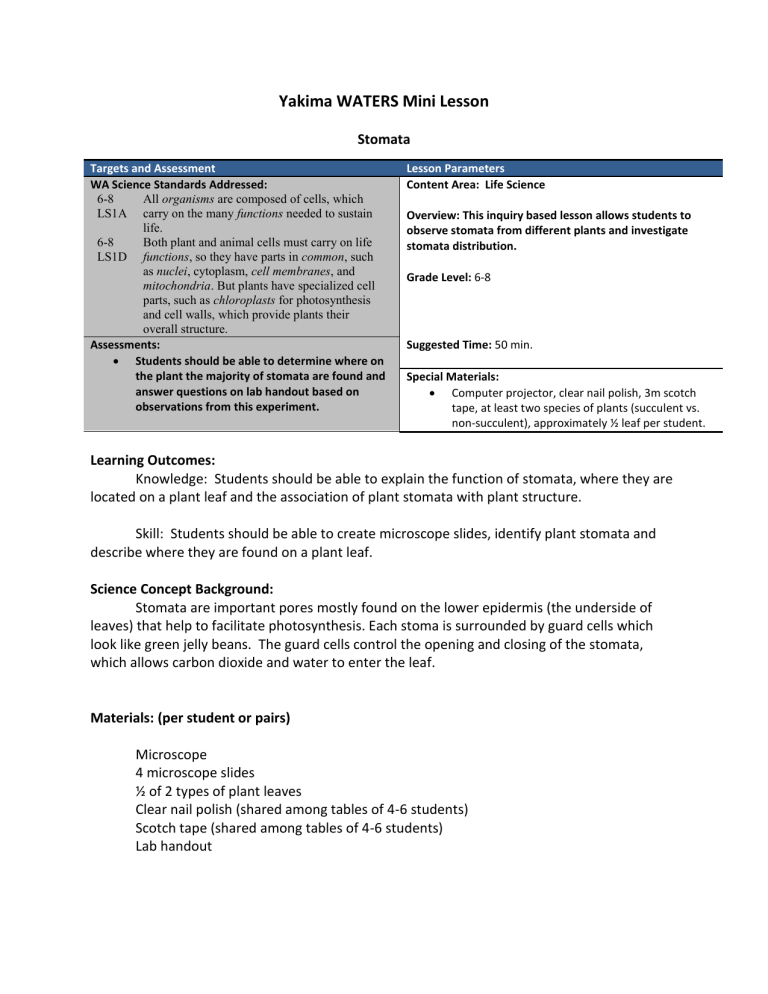
Yakima WATERS Mini Lesson
Stomata
Targets and Assessment
WA Science Standards Addressed:
6-8
LS1A
All organisms are composed of cells, which carry on the many functions needed to sustain life.
6-8
LS1D
Both plant and animal cells must carry on life functions , so they have parts in common , such as nuclei , cytoplasm, cell membranes , and mitochondria . But plants have specialized cell parts, such as chloroplasts for photosynthesis and cell walls, which provide plants their overall structure.
Assessments:
Students should be able to determine where on the plant the majority of stomata are found and answer questions on lab handout based on observations from this experiment.
Lesson Parameters
Content Area: Life Science
Overview: This inquiry based lesson allows students to observe stomata from different plants and investigate stomata distribution.
Grade Level: 6-8
Suggested Time: 50 min.
Special Materials:
Computer projector, clear nail polish, 3m scotch tape, at least two species of plants (succulent vs. non-succulent), approximately ½ leaf per student.
Learning Outcomes:
Knowledge: Students should be able to explain the function of stomata, where they are located on a plant leaf and the association of plant stomata with plant structure.
Skill: Students should be able to create microscope slides, identify plant stomata and describe where they are found on a plant leaf.
Science Concept Background:
Stomata are important pores mostly found on the lower epidermis (the underside of leaves) that help to facilitate photosynthesis. Each stoma is surrounded by guard cells which look like green jelly beans. The guard cells control the opening and closing of the stomata, which allows carbon dioxide and water to enter the leaf.
Materials: (per student or pairs)
Microscope
4 microscope slides
½ of 2 types of plant leaves
Clear nail polish (shared among tables of 4-6 students)
Scotch tape (shared among tables of 4-6 students)
Lab handout
Procedure:
Teachers: give a brief overview of lesson and lab exercise (do not tell students that most stomata are found on the lower epidermis). Have students conduct lab exercise, and then watch youtube links. Questions can be answered as homework if time runs short.
Key questions: Where are the stomata found on plants and what is the average density of stomata per field of view in a microscope slide?
Students:
Paint a thin layer of nail polish approximately the width of a piece of scotch tape the top of a leaf
Let nail polish dry
Place a piece of scotch tape over the painted area and rub tape
Prepare a slide by peeling the tape off of the leaf and sticking it onto the microscope slide
Place slide under microscope and bring to focus at 400x
Count and record the number of stomata in each field of view
Randomly move the slide four additional times counting and recording the number of stomata observed
Repeat this whole procedure for the bottom of this leaf and the top and bottom of additional leaves
Extension:
Watch a time lapse video of stomata opening and closing. http://www.youtube.com/watch?v=ofb0zkG5H2c&feature=related
Students can conduct research on different plant species and their adaptations to the environment they live in.
Teaching Tips:
Instead of lecturing about stomata use an easy to understand animation found on youtube (use link below) after students conduct lab exercise
Supplements: http://www.youtube.com/watch?v=IlmgFYmbAUg
Author: Amber Palmeri-Miles, Yakima WATERS Project, CWU, Winter 2011
Name__________________________________ Block____________ Date______________
Using your knowledge of the size of the area of field of view, determine the density of stomata for the top and bottoms of the leaves provided.
Area of field of view __________________
Slide 1: Top/ Bottom (circle one)
Number of stomata in field of view:
1.
2.
Type of leaf:
3.
Average number of stomata in the field of view __________
4. 5.
Density of stomata per square centimeter _______________
Slide 2: Top/ Bottom (circle one)
Number of stomata in field of view:
Type of leaf:
1.
2. 3.
Average number of stomata in the field of view __________
Density of stomata per square centimeter _______________
4. 5.
Draw one field of view with stomata and appropriate labeling:
Slide 3: Top/ Bottom (circle one)
Number of stomata in field of view:
2.
2.
Type of leaf:
3.
Average number of stomata in the field of view __________
Density of stomata per square centimeter _______________
Slide 4: Top/ Bottom (circle one) Type of leaf:
Number of stomata in field of view:
2.
2. 3.
Average number of stomata in the field of view __________
Density of stomata per square centimeter _______________
Draw one field of view with stomata and appropriate labeling:
4.
4.
5.
5.
Name__________________________________ Block____________ Date______________
Answer questions based on knowledge gained from video and personal observations:
1.
Where did you observe the highest density of stomata?
(bottom of the leaves)
2.
Which plant species had the highest density of stomata?
(non-succulent)
3.
What are stomata?
(pores that absorb and release gasses)
4.
Where are stomata found?
(lower epidermis)
5.
What structures control the exchange of gasses between the leaf and the atmosphere?
(guard cells)
6.
What gasses enter and leave the stomata?
( CO
2
, O
2
, and H
2
O)
7.
What factors regulate the opening and closing of stomata?
(biological rhythm, intensity of light , concentrations of CO
2
, and water balance)
